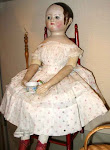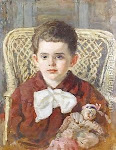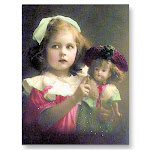
A Spanish countess, she was born in Granada, Spain, in 1826.
She was the beautiful and fashionable wife of Napoleon III and last Empress consort of the French from 1853 to 1871.
Manuela de Montijo and her two daughters: "Paca," future Duchess of Alba, and "Eugenia," future empress consort of France.
She was the daughter of a Spanish officer Don Cipriano Palafox y Portocarrero(1785–1839), 9th Count of Montijo Grandee of Spain amongst other titles, and her mother was from Scotch Roman Catholic descent.
Eugénie de Montijo, as she became known in France, was educated in Paris, at the fashionable convent of the Sacré Cœur, where she received a Catholic education. When Prince Louis Napoleon became president of the Second Republic, she appeared with her mother at several balls given by the "prince-president" at the Elysee Palace; it was there that she met the future emperor, whom she wed on 30 January 1853.
 Empress Eugenie de Montijo
Empress Eugenie de Montijo Napoleon III
Napoleon III



 The empress set standards for beauty and fashion in the French Court, having the best designers at her disposal. She also became noted for her extravagance. When the empress wore the new cage crinolines in 1855, European fashion followed suit, and when she abandoned vast skirts at the end of the 1860s, at the encouragement of her legendary couturier, Charles Frederick Worth, the silhouette of women's dress followed her lead again. Eugénie's aristocratic elegance, splendour of dress and legendary jewels are well documented in innumerable paintings, especially by her favourite portraitist, Franz Winterhalter.
The empress set standards for beauty and fashion in the French Court, having the best designers at her disposal. She also became noted for her extravagance. When the empress wore the new cage crinolines in 1855, European fashion followed suit, and when she abandoned vast skirts at the end of the 1860s, at the encouragement of her legendary couturier, Charles Frederick Worth, the silhouette of women's dress followed her lead again. Eugénie's aristocratic elegance, splendour of dress and legendary jewels are well documented in innumerable paintings, especially by her favourite portraitist, Franz Winterhalter. Elegant 19th-century use of flowers for personal adornment: “Empress Eugenie,” oil on canvas by Edouard Dubufe, 1854. In the Musee National de Versailles et des Trianons, Versailles, France.
Elegant 19th-century use of flowers for personal adornment: “Empress Eugenie,” oil on canvas by Edouard Dubufe, 1854. In the Musee National de Versailles et des Trianons, Versailles, France. A beautiful woman who did full justice to her crown. She was tall, with a neck spoken of admiringly at the time as swan like.
A beautiful woman who did full justice to her crown. She was tall, with a neck spoken of admiringly at the time as swan like.
The best of the Parian or Dresden dolls were made between 1850 and 1860. Most of the heads after 1860 were of coarser clay and not so fine in modeling. Of course there are exceptions, and indeed there is great variation even in heads of the same model. One of the most beautiful heads made before 1860 and a favorite among collectors, if we are to judge by the number who have it, is the Empress Eugenie, which may have been intended for a portrait of the young Empress of France. On these dolls the golden hair is arranged in a chignon or waterfall with a green or black net. On one side of the front of the head is an elaborate decoration of pinkish gold luster; on the other side there is some silver luster. Some collectors mistakenly call this hair net a "snood" but the "silken snood" is something quite different-a ribbon which the Scotch maiden bound in her hair as a token of her virginity.

 The Empress Eugenie holding Louis Napoleon, the Prince Imperial on her Knees... Winterhalter
The Empress Eugenie holding Louis Napoleon, the Prince Imperial on her Knees... Winterhalter
 The Prince and his father, Napoleon III of France.
The Prince and his father, Napoleon III of France. A Family Portrait
A Family PortraitNapoleon Eugene Louis Jean Joseph Bonaparte, Prince Imperial, Fils de France, was the only child of Emperor Napoleon III of France and his Empress consort Eugenie de Montijo. His early death in Africa sent shock waves throughout Europe, as he was the last dynastic hope for the restoration of the Bonapartes to the throne of France.

On June 1, 1879, the Prince formed part of a scouting party around the area of what is today Zimbabwe. Approximately 40 warriors surprised the party slaying the Prince and two other soldiers.
 The Prince with his dog "Nero"
The Prince with his dog "Nero" The Empress and her son, Louis Napoleon, painting by Tissot.
The Empress and her son, Louis Napoleon, painting by Tissot.*************************************************************


After the battle of Sedan, in which her husband was captured, she was urged to flee from Paris. After his release, Napoleon and Eugenie were forced to live in exile in England from 1870 until her death in 1920.


The former empress died in July 1920, aged 94, during a visit to her relatives, the Dukes of Alba in Madrid, in her native Spain, and she is interred in the Imperial Crypt at St. Michael’s Abbey, Farnborough, with her husband and her son.
 The Crown of Empress Eugénie was the consort crown of Eugenie de Montijo, the empress consort of Emperor Napoleon III of France. Though neither she nor her husband underwent a coronation a consort crown was specially created for her.
The Crown of Empress Eugénie was the consort crown of Eugenie de Montijo, the empress consort of Emperor Napoleon III of France. Though neither she nor her husband underwent a coronation a consort crown was specially created for her.After her husband was overthrown in 1870, following the Franco-Prussian War, Napoleon and Eugénie lived in exile in the United Kingdom. She was the last surviving French person to have worn a crown.
Though most of the French Crown Jewels were sold by the French Third Republic in 1885, the Crown of Empress Eugénie was kept and is on display in the Louvre museum in Paris.













































.jpg)









































































So far, very beautiful and informative, but I will have to return when I have more time to read it all. You could make a sweet little booklet of this one!
ReplyDeleteOff the subject; I hope your staged performance was a wonderful success!
Great post. A name I'd heard of but knew nothing about. The dolls really add to it. Many thanks.
ReplyDeleteThank you Christine...This is one of the loveliest Parian dolls as well as the wonderful bisque Bru's. A tribute to a beautiful woman nonetheless. It's almost unbelievable that her husband proved to be a philanderer. I didn't go into that part of the story, she really wasn't a happy empress, and after her son's death she just fell apart.
ReplyDeleteThe stage play , was a great experience... Hope I can do more in the future.
Bisous
Thank you Hermes...She is one of my favorite ladies in history. Beautiful and sad.
ReplyDelete